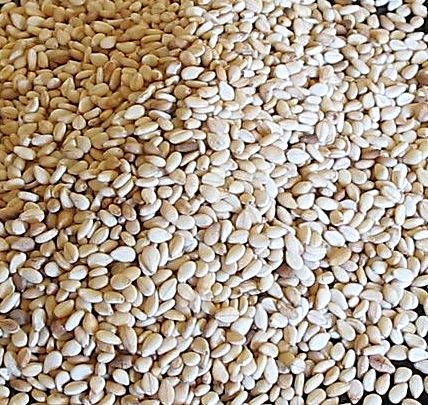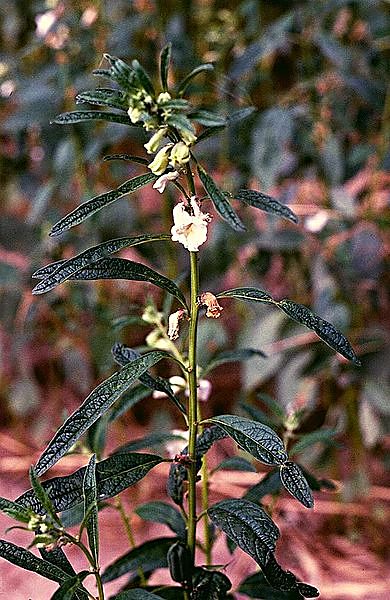 Sesame (Sesamum indicum) or popularly known as “linga” in the Philippines. Sesame is a member of the Pedaliaceae family and a native to tropical Asian countries.. It is widely naturalized in tropical regions around the world and is cultivated for its edible seeds, which grow in pods. The sesame plant can grow to a height of three feet and is an annual herb. It is an erect plant covered in fine hair and has a square stem. The leaves are flat, lanceolate in shape and grow in clusters of twos and threes. The flowers are pinkish purple in color or white and are bell shaped. The name sesame is derived from Middle English sisame and from the Latin sesamum.
Sesame (Sesamum indicum) or popularly known as “linga” in the Philippines. Sesame is a member of the Pedaliaceae family and a native to tropical Asian countries.. It is widely naturalized in tropical regions around the world and is cultivated for its edible seeds, which grow in pods. The sesame plant can grow to a height of three feet and is an annual herb. It is an erect plant covered in fine hair and has a square stem. The leaves are flat, lanceolate in shape and grow in clusters of twos and threes. The flowers are pinkish purple in color or white and are bell shaped. The name sesame is derived from Middle English sisame and from the Latin sesamum.
Sesame seeds are tiny, flat oval seeds with a nutty taste and a delicate, almost invisible crunch. They come in a host of different colors, depending upon the variety, including white, yellow, black and red. Sesame seeds are highly valued for their high content of sesame oil, an oil that is very resistant to rancidity.
Sesame seeds are sometimes added to breads, including bagels and the tops of hamburger buns. Sesame seeds may be baked into crackers, often in the form of sticks. Sesame seeds are also sprinkled onto some sushi style foods. Whole seeds are found in many salads and baked snacks as well in Japan.
Chinese cuisine use sesame seeds and oil in some dishes, such as dim sum, and sesame seed balls. Sesame flavour (through oil and roasted or raw seeds) is also very popular in Korean cuisine, used to marinate meat and vegetables. Chefs in tempura restaurants blend sesame and cottonseed oil for deep-frying. Sesame oil was a preferred cooking oil in India until the advent of peanut oil.
Sesame (linga) oil is used, not only for cooking food, but also for the manufacture of other things, such as margarine, soap, cosmetics, perfume, insecticides, pain and medicine. Interestingly, nutrients from one seed to another vary, but they all contain protein, oils lecithin, minerals (Ca, P, K, Fe) saccharide, cellulose, VB2, VE, niacin, folic acid, sterol, sesamd, sesamin and cytochrome C. Sesame is supposed to tonify kidney, liver and relax the bowel. It is used for the treatment of constipation due to hard stools, tinnitus, anaemia, clizziness and poor vision. Mix powdered toasted sesame seeds with ground tuckahoe. Stir one to two teaspoonful into warm water and take in the mornings. Infuse the leaves in some hot boiling water and use this to gargle and treat inflamed membranes of the mouth. Use only after tea has cooled down.
There are many kinds of sesame. The following varieties yield good harvest and abundant oil: Sri Lanka Black, Japanese Black, and Iligan Marinduque Black, which are native to us. The white varieties that similarly yield good harvest and abundant oil which are used for special cuisine, are: the Japanese White, Guatemala White, Mexican White and our own native white variety. These are resistant to pests and diseases. Sesame grows in warm weather. This will not thrive in temperature as low as 21°C. It can withstand dry weather, but also needs watering as it grows. Because sesame seeds are very tiny, it seeds should be planted shallow in soil, free from weeds, does not retain water, and fertile.
Production of Sesame

Planting
The distance of the plants from one another should be one-half meter apart if the variety does not bear branches, and 70-80 cm apart if it bears branches. Mix the seeds with sand, and plant 5-10 seeds in a hole about 10-15 cm apart if it is branch-bearing, and only 8-12 cm if it is not branch bearing. In one hectare of land, 4-6 kilos of seeds can be accommodated. Irrigation is necessary in planting, but only once or twice after planting when it is growing. It needs watering before flowering and before fruit bearing.
Germination
The seeds germinate 5-7 days after sowing. Two weeks after germination, remove some leaves and branches and transplant the plant. Leave only two strong plants in every hill. After 3-4 weeks when the plants are sturdy, loosen the soil (culture). Culture again when the plant is 30 cm high. Always remove the weeds because this will diminish the capacity for fruit bearing.
Applying Fertilizer
Sesame does not like humid and rainy place. In rainy season, it is vulnerable to disease, so choose only varieties that are resistant.
Do not plant sesame repeatedly in the same area after harvest, so as to avoid disease or pest. Do not use insecticide containing sulfur because this is not good for sesame.
Harvest
- The sesame plant flourishes from 85-150 days. Harvest when flowering stops, and the leaves turn yellow and fall off.
- The pods burst out when these are ripe, so the seeds will scatter. Cut off the pods when still green and bunch them.
- Spread the branches on a mat and thick cloth and put these under the sun.
- When dried, beat the branches to bring out the seeds. Clean off the stones and dirt, and branches.
- Dry the seeds before storing. If they are for planting, apply chemical on the seeds to keep pests away.
Source: www.elgu2.ncc.gov.ph; Photos: wikipedia.org